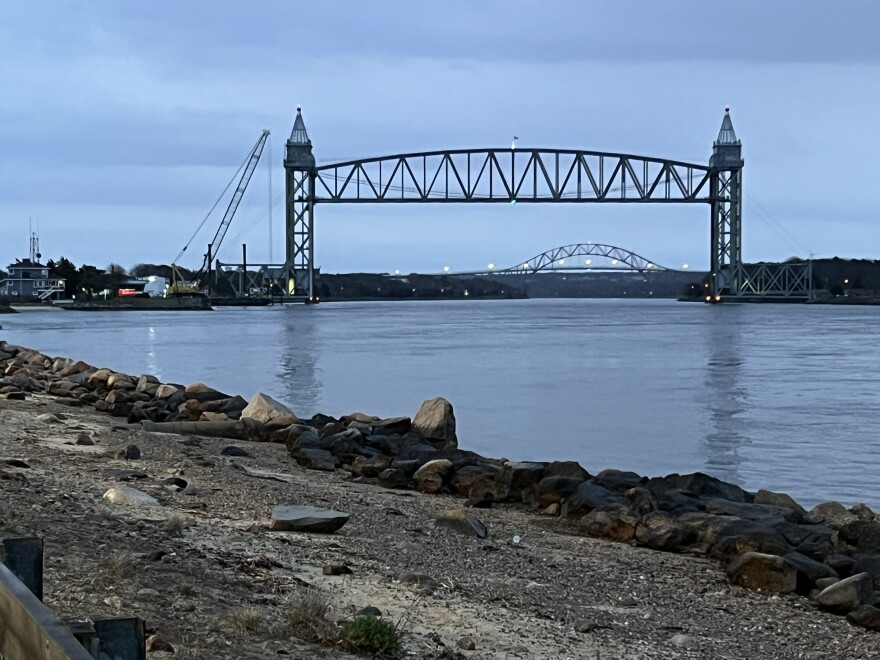Sagamore Bridge neighbors who stand to lose their homes for the replacement bridge, or who will end up living directly next to the bridge, spoke directly to the state’s head of the project at a public forum last night in Bourne.
One resident of Cecilia Terrace, Joyce Michaud, said she’ll lose not only her home, but also her wedding-cake and catering business and income from a basement apartment.
“How can you say I’m going to be no worse off?” she asked. “I’m living on a fixed income. I have to do this to make ends meet.”
Luisa Paiewonsky, executive director of the state Office of Megaproject Delivery, gave an overview of the project and answered questions, along with other staff from the Massachusetts Department of Transportation and consultants.

Another resident near the Sagamore Bridge, Marc Hendel, said his home is slated to be taken by eminent domain.
“Every day the stress is totally unbearable,” he said. “The toll on our mental and physical health is visible to us every single day. We're confused, we're angry, we are stressed, we’re worried about our future.”
Paiewonsky said the state will make people whole financially, but she said she knows losing a home is not just a financial issue.
“We can't replace your home exactly for you,” she said. “We understand that this is hugely disruptive. … I do acknowledge how upsetting this is to you and your family.”
The state has notified affected homeowners. Some properties will be taken for the bridge itself, and others for roadways that approach the bridge, stormwater management infrastructure, shared-use paths for pedestrians and bicycles, and access points for maintenance and operations.
“But I wanted you to hear directly from us that it is something we try to avoid,” Paiewonsky said. “And we try to handle it as sensitively as we can.”

On the issue of business disruption, she referred the question to John DeLeire, director of DOT’s Right of Way Bureau, who said someone with a home-based business and a tenant is entitled to enough compensation to recreate those same features in a replacement property.
As for business downtime during the move, he said, “We try to coordinate it as best we can, so that you don't have any lag time between moving from your home with your business working, to your new location."
Dave Collins, who lives on Eleanor Avenue, said that although his home will not be taken, the parcel across the street from him will.
“I'm 81 years old,” he said. “I'm a combat vet, and I won't live long enough to see the bridge done. I've got stage 4 cancer. And I'll be damned if I want to sit there the rest of my life, and watch that bridge be built out my front door, and listen to it day and night while they work on it.”
He asked the state to build some kind of wall to protect neighbors from dirt and noise.
Collins also said that abutting the new bridge will slash the value of his house and make it hard to sell.
“I just had my house evaluated by a professional,” he said. “As soon as he looked at the plans for the bridge, he knocked $100,000 off the value of my house. He said you'd be very lucky to ever sell it when the bridge is done.”
He wants the state to know, he said, that for residents whose homes will be left behind after the eminent-domain takings, “we're stuck with something we'll never get rid of.”
In an interview after the meeting, Paiewonsky said loss of property value is not part of the state’s compensation program.
“We compensate homeowners for the impacts to their home, such as if a contractor runs equipment over their lawn or damages a part of their house. … But we don't compensate for actual or perceived loss in value of the house,” she said.
Nor does the state pay compensation for living near a construction site, but it does have “very active” mitigation programs to limit noise, dust, and the hours of work, she said.

More than 100 people turned out for the forum, hosted by state Sen. Dylan Fernandes at Massachusetts Maritime Academy.
Cape Cod residents from outside the immediate bridge neighborhoods asked questions about the bridge locations and funding, how traffic from larger bridges will affect local roads, and whether any of the contractors will come from the surrounding region, among other issues.
Some confusion about the timeline for the Sagamore Bridge arose when one of the state slides estimated the duration of construction at eight to 10 years — noticeably longer than the previous six to eight years the agency has given.
But in an interview, Paiewonsky said the 10-year timeline includes the environmental permitting, hiring a contractor, and design work, prior to actual construction. Construction is scheduled to last seven to eight years, which she called “fairly conservative.”
“We're going to be looking for opportunities to shorten up the time frame of construction, but we don't want to be overestimating how quickly we can do that until we hear from the contractor,” she said.
Environmental permitting documents will be filed this summer, and preliminary design should be complete by the following summer, according to the DOT timeline.
The state expects to issue a draft Request for Proposals for a design-build contract in the fall of next year, and the official notice to begin work sometime in the winter of 2027-2028.
If construction lasts eight years from then, the Sagamore will be done in 2036.
The state hopes the Bourne Bridge can be done on a similar schedule, lagging behind the Sagamore by only a year or two. But that depends on federal funding.








